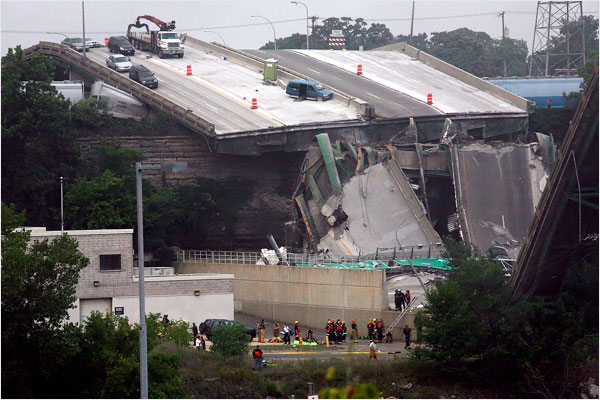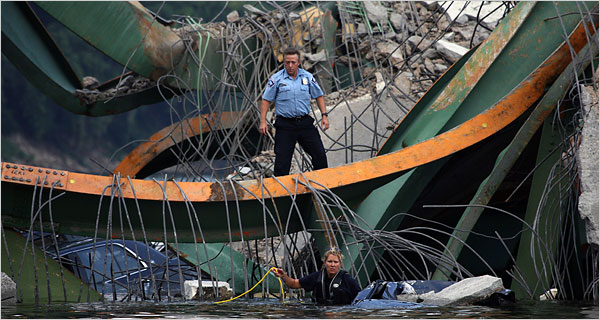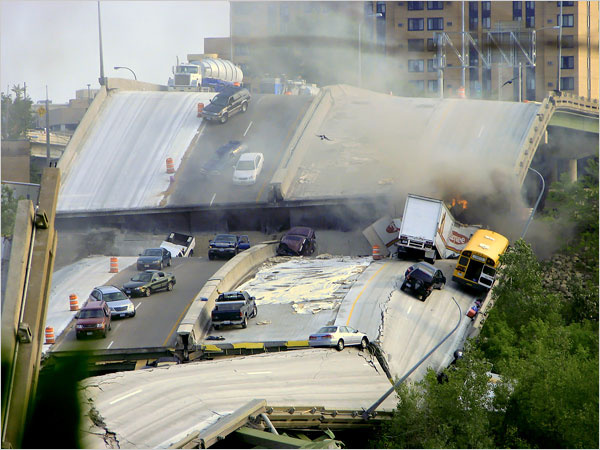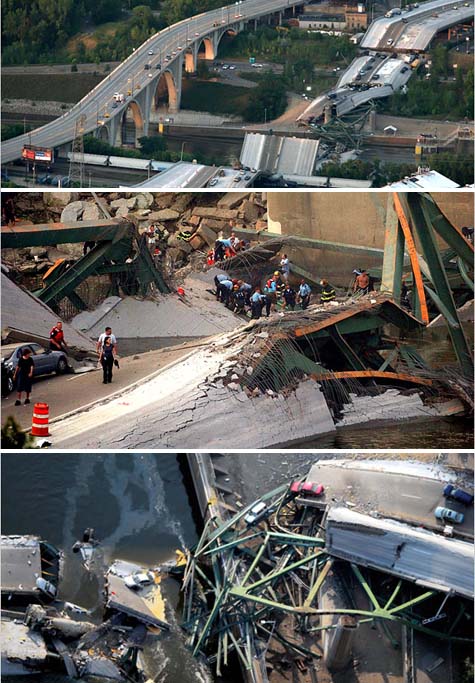 [Image: Photo by Allen Brisson-Smith for The New York Times].
[Image: Photo by Allen Brisson-Smith for The New York Times].
After yesterday’s bridge collapse in Minneapolis – a bridge my sister and her family drove across everyday – the decaying state of American infrastructure is becoming all the more apparent.
Last month it was an exploding steam pipe in Manhattan; a few years ago it was the levees of southern Louisiana; and anyone who drives a car in the U.S. has probably noticed that the roads here are not particularly well-kept. The sheer number of potholes in the city of Philadelphia, for instance, was enough to convince me, only half-jokingly, that if the city was not going to spend any money fixing the streets, then they should at least help underwrite repair bills for all the broken axles, blown suspensions, and sometimes major fender benders caused by the city’s rather obvious display of custodial irresponsibility.
 [Image: Photo by Jeff Wheeler/The Star Tribune/AP; via The Guardian].
[Image: Photo by Jeff Wheeler/The Star Tribune/AP; via The Guardian].
In any case, The New York Times opines today that these system-wide failures “are an indication that this country is not investing enough in keeping its vital infrastructure in good repair.”
Transportation officials know many of the nation’s 600,000 bridges are in need of repair or replacement. About one in eight has been deemed “structurally deficient,” a term that typically means a component of the bridge’s structure has been rated poor or worse, but does not necessarily warn of imminent collapse.
Most deficient bridges, which included the span of Interstate 35W over the Mississippi River in Minneapolis, remain open to traffic.
Worse, 13.6 percent of U.S. bridges – i.e. more than 81,000 bridges – are “functionally obsolete.”
 [Image: Photo by Heather Munro/The Star Tribune/AP; via The Guardian].
[Image: Photo by Heather Munro/The Star Tribune/AP; via The Guardian].
Ironically, only six days ago the Federal Highway Administration announced a $5.3 million grant program meant to stimulate and reward innovative research in bridge repair and design.
“Nearly $5.3 million in grants will be awarded to bridge projects in 25 states to help develop new technologies to speed bridge construction and make them safer,” we read on the FHA website.
None of those grants will be going to Minnesota.
 [Images: Photos courtesy of The New York Times].
[Images: Photos courtesy of The New York Times].
It’s interesting to point out, then, that the Federal Highway Administration’s annual budget appears to be hovering around $35-40 billion a year – and, while I’m on the subject, annual government subsidies for Amtrak come in at slightly more than $1 billion. That’s $1 billion every year to help commuter train lines run.
To use but one financial reference point, the U.S. government is spending $12 billion per month in Iraq – billions and billions of dollars of which have literally been lost.
Infrastructure is patriotic.
There is no reason to question the political loyalties of those who would advocate spending taxpayer dollars on national infrastructure – from highway bridges and railway lines to steam pipes, levees, electrical lines, and subway tunnels – instead of on military adventures abroad.
Four months of foreign war would be enough to double the annual budget for the Federal Highway Administration – if that’s what one would choose to spend the money on – taking care of quite a few of those 81,000+ bridges which are still open to traffic and yet “functionally obsolete.”
Perhaps the best way to be “pro-American” these days is to lobby for modern, safe, and trustworthy infrastructure – and the economic efficiencies to which that domestic investment would lead.
At the risk of promoting a kind of isolationist infrastructural nationalism, I’d say that urban design and engineering is a sadly under-appreciated – yet incredibly exciting – way to serve your country.